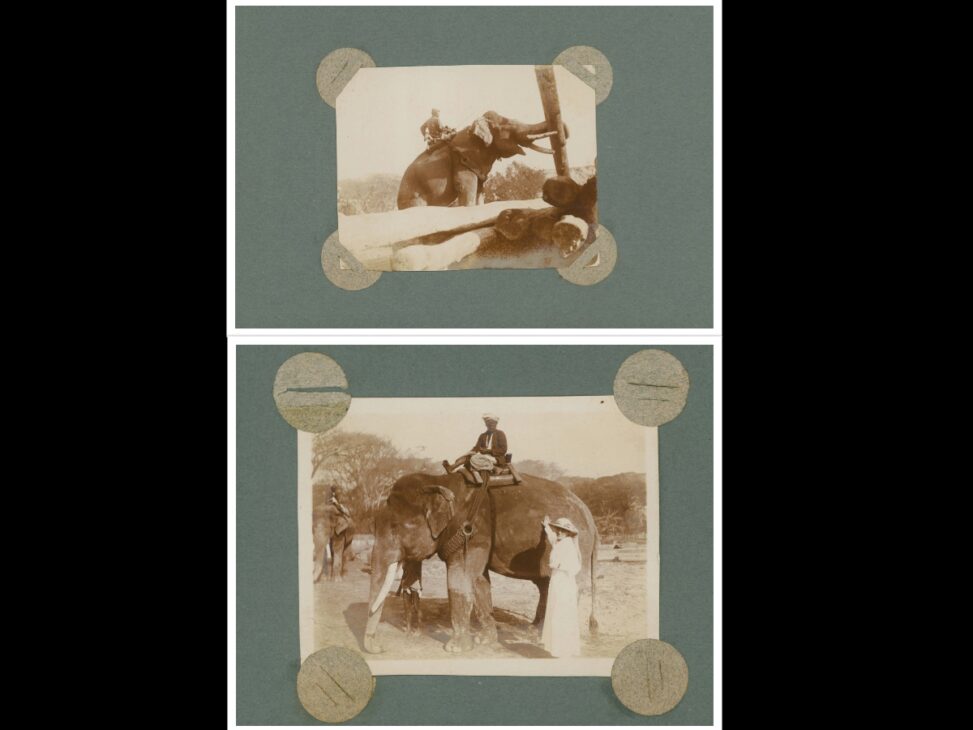Introduction/Photo Analysis
These two photos, part of a collection of four photo albums from George West Philleo, display a lumber yard in Penang, Malaysia in the late 19th century. A darker-skinned man (presumably Malaysian), is photographed working with an elephant in the yard while the British tourists pose with the man and the elephant in the second photo. Characteristic of this period of colonization within Southeast Asia, native populations serve as the source of hard labor while white colonizers oversee the extraction of natural resources and exploitation of the country. The hard labor that is present due to influence colonizing forces serves as a point of tourism for rich, white ariostocrats.
Colonialism and the Malaysian Forest
Colonization has scarred Malaysian history beginning in the 16th century with Malacca falling to the Portuguese in 1511. Malaysia was passed from the Portuguese to the Dutch in 1641, and finally to the British in 1824. In 1957, Malaya finally gained independence with Sabah, Sarawak, and Singapore joining in 1963 to form Malaysia (“Summary of Malaysia’s History”, n.d). The British established a capitalistic economic system within Malaysia, shifting work towards farming cash crops. During this time, the rubber tree was extremely profitable, so the British introduced the tree to Malaysia in the 1870’s for production. However, this required the clearing of vast amounts of forest with thousands of acres cleared by the early 20th century. Eventually, Malaya became the world’s greatest exporter of natural rubber, providing most monetary gain to the British colonizers (“Impact of British Rule”, n.d.).
In addition to clearing space for rubber plantations, logging in Malaysia prior to the 20th century was conducted primarily to meet domestic needs for railways, fuelwood, and timber for infrastructure (Leng, n.d.). With the thick forests of Malaysia, logs and wood were an abundant and easily available resource. Eventually, the British began exporting this lumber internationally after the Second World War, culminating in Malaysia having the world’s highest deforestation rate by 2013 with almost 10 percent of its forest cover being lost between 1990 and 2010 (Butler, 2013). The forest industry in Malaysia has served as one of the major driving factors for economic development in the country. Currently, much of this deforestation is driven by the extraction of palm oil. In addition to Indonesia, 85% of the global supply of palm oil is produced in the region, exacerbating deforestation in the area. The logging industry in Malaysia is also one of the main sources of employment for Malaysians with more than 1 in 7 working in the industry (“Malaysia Forest Information and Data”, n.d.).
Labor in Colonial Malaysia
As was common in many colonized parts of the world, slavery and debt bondage was utilized by colonizing forces to extract natural resources. During the time of British occupation in Malaysia, the British also occupied India. With the logging industry proving very profitable, the British utilized debt bondage to bring over a million Indians to Malaya to work on rubber plantations between 1844 and 1938. Debt bondage, the practice of utilizing labor as a way to repay debt, was the main way these laborers were brought to the rubber plantations. Obtaining debt from the empire through many different routes, citizens of these British colonies were mainly conducting hard labor with very little “pay” (“Forced Labor in Malaysia…”, 2021). The exploitation of native labor was rampant at the time, displayed by the demographic in the above photo.
Even today, debt bondage is still alive in Malaysia. In 2021, documents were released by the Los Angeles Times detailing many migrants paying mandatory recruitment fees, adding to their debt before they were even employed. The low wages provided at these jobs makes it almost impossible to overcome the debt (“Forced Labor in Malaysia”, 2021). Therefore, these workers are in a cycle of debt, chained to their labor-intensive jobs until they are able to find a way out.
Archival Photographs and Insight on History
These photos by George West Philleo directly displays the beginnings of one of Malaysia’s most influential industries to date. With British influence in the region, Malaysia transformed from a country with lush, tropical forests to one plagued with deforestation. The photos exemplify this relationship between the British and Malaysian people as the British seem to be delegating, observing, and photographinfg the operation while the Malaysians or other colonized people are doing the hard labor. The extraction of these resources was conducted, initially, primarily by the British under their rule. Working to repay their debt or to earn what little money they could in the colonial economy, these people were unknowingly, and often unwillingly, engaging in the early stages of destruction of their home.
Works Cited
Butler, R. A. (2013, November 15). Malaysia has the world’s highest deforestation rate, reveals Google Forest Map. Mongabay Environmental News. Retrieved April 26, 2023, from https://news.mongabay.com/2013/11/malaysia-has-the-worlds-highest-deforestation-rate-reveals-google-forest-map/
Encyclopædia Britannica, inc. (n.d.). Impact of British Rule. Encyclopædia Britannica. Retrieved April 26, 2023, from https://www.britannica.com/place/Malaysia/Political-transformation
Forced labour in Malaysia – what the UK can do. Unseen. (2021, February 24). Retrieved April 26, 2023, from https://www.unseenuk.org/forced-labour-in-malaysia-what-the-uk-can-do/
Leng, Y. K. (n.d.). Some aspects of forestry and economic development in Malaysia: Past and present. Economic History Malaya. Retrieved April 26, 2023, from https://www.ehm.my/publications/articles/some-aspects-of-forestry-and-economic-development-in-malaysia-past-and-present
Malaysia Forest Information and Data. Malaysia Forest Information and data. (n.d.). Retrieved April 26, 2023, from https://rainforests.mongabay.com/deforestation/2000/Malaysia.htm
Summary of Malaysia’s History. Mygov – the government of Malaysia’s Official Portal. (n.d.). Retrieved April 26, 2023, from https://www.malaysia.gov.my/portal/content/30120
